
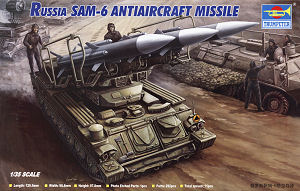
Russia SAM-6 Antiaircraft Missile
Trumpeter Kit No. 00361
1:35th Scale
Review by Terry Ashley
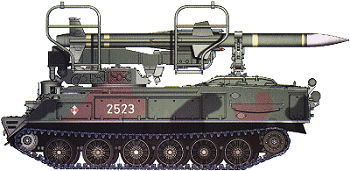



Trumpeter continue to release varied and interesting subjects with this kit being no exception featuring the Soviet/Russian 2K12 anti-aircraft system (referred to as the SAM-6 Gainful by NATO) which carries three 3M9, 3M9M1 or 3M9M3 missiles. This system gained notoriety at the beginning of the 1973 Israeli-Arab war by downing a number of IAF aircraft before effective countermeasures could be implemented and has been used by up to 25 countries including against British and US aircraft in Serbia and Iraq.
The kit consists of 353 parts in light grey plastic with two small springs, two lengths of plastic tubing and a length of fine wire, a small etched fret plus the decal and instruction sheets
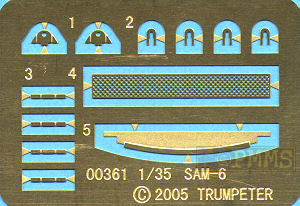
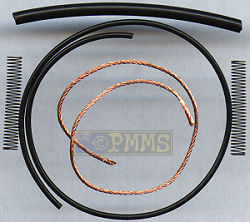
Standard of moulding is very good with virtually no pin ejector marks in places that can be seen after assembly with quite extensive use of multi-part (slide moulds) to add well defined details to both the larger and smaller parts.
The details are well defined on most parts but there are some fairly prominent mould seam lines to be removed from some of the parts but this is easy to deal with during the normal cleanup on any kit.
Lower Hull:
The lower hull tub is an impressive moulding which features extensive hull
bottom details with indented recesses and raised panel detail as well as
side axle mount details and the upper sponson filler included. There are
separate parts for the rear panel although this needed some minor trimming
at the sides for a good fit plus separate bump stops and axles for the suspension.
Additional smaller fittings are provided for the front and rear panels.
The drive sprockets are in two halves with open lightening holes on the outer sprocket with a separate final drive housing attached to the hull side with the idler wheels being simple one piece mouldings. The road wheels have the contoured disc details on both sides which is quite nice but the rounded profile of the contours is not quite there but will look okay on the finished model. The wheels attach to separate axle stubs which have the correct offset for the torsion bar suspension with square locating points to help line them up correctly. There is unfortunately a bit of play with these joins and you will have to ensure all the axles are lined up correctly before the glue dries with the first, second and fifth axles having small attachment arms that help to get the correct sit for these and the other free axles can be lined up with these for the right ride height.
The track is in moulded link and length plastic that has nice plate details with the long track section used for the upper and lower track runs and individual links to go around the drive sprockets and idler wheels and as there are no side skirts there shouldn’t be any problems fitting the track at any stage.
Upper Hull:
The upper hull is again an impressive single moulding with well defined side
and top details with all upper hatch and access panels as separate parts
so as not to compromise the detail.
The side access panels are all moulded in place but the details are well defined
due to the multi-part moulds.
The large engine deck is also a separate part but this required a bit of trimming for a good fit but the other access panels and hatches all fitted well. The two front driver’s hatches have basic details on the inside and a couple of pin marks but these probably won’t be shown open as there is no interior to see. The upper driver’s periscopes are a separate part with solid plastic periscopes but with the wiper blades included.
Other details include the separate headlights and covers, numerous small grab handles and small fittings from etched brass while at the rear is the etched intake screen which needs to be bent to a slight curve before fitting which shouldn’t be a problem.
Interestingly the circular missile launcher base (part C37) attached to the hull top has bolt head details around the inside lip but this is completely hidden once fitted to the hull, but I guess someone knows they are there?
The many smaller separate details items including the pioneer tools give good detail definition as well as portraying the “busy” look typical of Russian vehicles. The fit of the upper and lower hulls is very good without any trimming needed with the sponson extensions on the lower hull making for a fully enclosed hull when assembled.
Launcher and Missiles:
The lower launch platform is another part moulded with multi-part slide moulds
with the top, sides and front panel included with very well defined details
included. The lower base with turntable ring required a bit of trimming at
the front for a good fit and the usual trial fitting will determine what
is needed and there are other smaller details added. The piping at the rear
is interesting in that it uses the springs provided that is fitted over the
plastic tubing to give a textured look to the plumbing.
The rear square support box has four parts that again fit together well but will need the join seams eliminated for a more solid look which is quite easily done once the glue has dried as there is not much fine detail to get in the way of the cleanup.
The three missile launch rails are made up of four parts each, the two sides with separate top and bottom with each having nice details included. These parts fit together well but there are again some seams along the top and bottom joins that will need careful filling for a more compete look and you must take care not to damage any of the fine details during this process. The plastic tubing provided is used for the ducting from the rails to the missiles when loaded and this adds nice detail but the plastic tubing bends are very uniform and this piping is uneven in photos. One way of depicting this is to insert thickish copper wire inside the plastic tubing allowing you to add bends which will hold their shape.
The launch rails are secured to their main support cross member and to the lower launch pad mounting box and you have a choice of attaching these in the lowered travel position or raised firing position. It shouldn’t be too hard to make the launch box hinges workable as the brackets (parts B30, C61) already have small pins inside the end U bracket and the connecting arms (parts B31) have holes in each end as if Trumpeter were going to make these workable but had second thoughts just showing them to be glued together in the raised or lowered position. Either this or they just forgot to show in the instructions the parts are movable if not glued. The pivoting brackets (C61) have large pins that fit through holes in the base (part D6) that again show they were designed with movement in mind and to attach these all you need do is use a heated screwdriver to flatten out the end of the pin before gluing the base plate (part D15) in place.
The three missiles have fairly plain bodies in two halves and lack any of the access panel detail of the actual missile and appear to be based on a training or dummy missile. Added to the body are additional fairings and the forward and aft fins which are moulded in one piece each with thin leading and trailing edges. The kit missiles are quite close in size to published sizes and apart from the smooth bodies look quite convincing although there is no stencil data included on the decal sheet with the real missiles having considerable stencil data.
The large missile transport rack is in two parts with additional detail parts including separate clamps for holding the missiles in the travel mode.
The large “bed frame” rails on either side of the missiles are provided in thin mouldings although you will have to carefully remove the moulding seam line from the railings which shouldn’t be a problem and the connecting railings are separate and can be attached in the firing or travelling position.Decals:
The decal sheet has markings for five vehicles with just insignia and vehicle
numbers but as mentioned there is no vehicle or missile stencilling included.
The markings are for two Russian, one East German, one Polish and one Czech
vehicle.
Instructions:
These are the usual exploded view drawings which are very easy to follow as
there are no really complicated assembly sequences. Also included is a colour
sheet showing three of the colour schemes but only side views of the Polish
and Czech vehicles which have a three colour scheme so you will have to imagine
the rest of the scheme or find additional references.
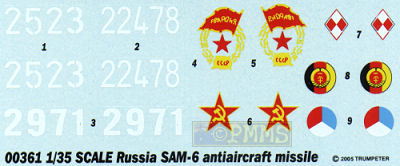
Conclusion:
Overall a very good representation of the SAM-6 and as mentioned portrays the
busy feel of typical Russian vehicles well and will form the basis for a very
good model as well as offering scope for plenty of additional detailing.
Should be welcomed by Modern Vehicle modellers
Highly recommended.
The Sprues: Click on thumbnails for larger view






Detail Images


Close new window to return to review
References:
Tomáš Bouchal has added a large walkaround
series of SA-6 photos on his site http://www.militaryvehicles.cz,
well worth a look. (Click on "Vehicles in Detail" and the 2P25M2 Icons)
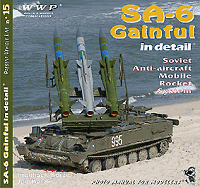 SA-6
Gainful in
details
SA-6
Gainful in
details
Present Vehicle Line No.15
Wings & Wheels Publications
Kit
courtesy of my Credit Card and the excellent service from Rainbow
Ten.
Page created November 2, 2005